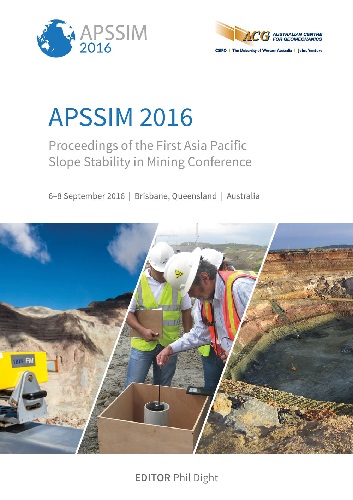Research on quality factor for evaluating stability of high and steep rock slope fractured by underground mining

|
Authors: Hu, J; Li, S; Li, P; Lin, F; Xing, Z; Peng, F; Lin, Z; Bao, J; Yu, Z Paper is not available for download Contact Us |
DOI https://doi.org/10.36487/ACG_rep/1604_45_Hu
Cite As:
Hu, J, Li, S, Li, P, Lin, F, Xing, Z, Peng, F, Lin, Z, Bao, J & Yu, Z 2016, 'Research on quality factor for evaluating stability of high and steep rock slope fractured by underground mining', in PM Dight (ed.), APSSIM 2016: Proceedings of the First Asia Pacific Slope Stability in Mining Conference, Australian Centre for Geomechanics, Perth, pp. 663-670, https://doi.org/10.36487/ACG_rep/1604_45_Hu
Abstract:
Dahongshan iron ore mine, in China, is a mine that operates both open pit and underground mining at the same time. The ultimate slope will be 435 m high with an overall slope angle of 47°. Underground mining is using the sublevel caving method. Secondary stress by underground mining may seriously deteriorate the stability of the slope. In order to monitor and evaluate the stability of the slope, based on the microseismic monitoring system with 18 sensors installed in the slope, using the calculation method of the amplitude’s attenuation and frequency domain of seismic wave, this paper deduced calculation formula of quality factor based on the dynamic blasting location and uniaxial sensors. This paper obtained continuous dynamic three dimensional quality factor value of the slope rock mass for evaluating the stability and damage degree of the high and steep slope. The results revealed that the quality factor of the rock slope was generally stable in 2015, indicating that there were minimal secondary stress impacts from underground mining. The slope is, so far, still stable.
Keywords: high and steep slope, quality factor, open and underground united mining, microseismic monitoring
References:
Gong, T, Sun, C, Peng, H, Xiao, Y & Sun, T 2009, ‘Comparison of several computational methods of quality factor’, Journal of Progress in Exploration Geophysics, 32(4), pp. 252—256. [in Chinese]
Hu, J, Li, S, Lin, F, Peng, F, Yang, S & Yu, Z 2014, ‘Research on disaster monitoring of overburden ground pressure and surface subsidence in extra-large mined-out area’, Journal of Rock and Soil Mechanics, (4), pp. 1117—1122. [in Chinese]
Ma, Z & Liu, Y 2005, ‘A summary of research on seismic attenuation’, Journal of Progress in Geophysics, 20(4), pp. 1074—1082. [in Chinese]
Occhiena, C & Pirulli, M 2012, ‘Analysis of climatic influences on slope microseismic activity and rockfalls: Case Study of the Matterhorn peak (Northwestern Alps)’, Journal of Geotechnical and Geoenvironmental Engineering, 138(8), pp. 1012–1021.
Occhiena, C, Pirulli, M & Scavia, C 2014, ‘A microseismic-based procedure for the detection of rock slope instabilities’, International Journal of Rock Mechanics and Mining Sciences, 69, pp. 67–79.
Paulsen, JC, Kistler, RB & Thomas, LL 1967, ‘Slope stability monitoring at Boron’, Mining Congress Journal, 53(9), pp. 28–32.
Stuart, N & Vladut, T 1986, ‘Microseismic data processing associated with monitoring of mine slope instabilities’, in Proceedings of the 39th Canadian Geotechnical Conference In Situ Testing and Field Behaviour, Ottawa, pp. 51–58.
Wisecarver, DW, Merrill, RH & Stateham, RM 1969, ‘Microseismic technique applied to slope stability’, Transactions Society of Mining Engineer, vol. 244, pp. 378–385.
© Copyright 2025, Australian Centre for Geomechanics (ACG), The University of Western Australia. All rights reserved.
View copyright/legal information
Please direct any queries or error reports to repository-acg@uwa.edu.au
View copyright/legal information
Please direct any queries or error reports to repository-acg@uwa.edu.au